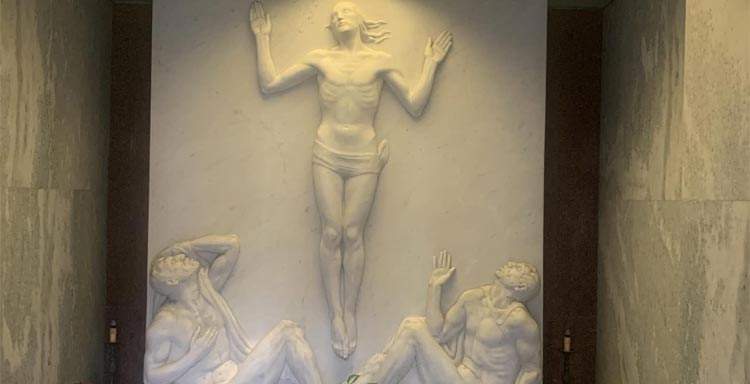“Unfortunately yet another bad intervention on the Ortelli Tomb in Cernobbio...without any criteria and no historicization...where will the original cross and marbles have gone? Where was the Superintendence? Who authorized the havoc?” With these words a few days ago, the Giuseppe Terragni Archive, which passes on the memory of the great rationalist architect (one of the fathers of the Italian international style, famous above all for the Casa del Fascio in Como and the Palazzina Novocomum), in a post published on its Facebook profile, denounced what happened to the Ortelli Chapel, a work by Terragni that is located at the Cernobbio Cemetery.
The Ortelli Chapel, as stated on the website of MAARC, the Virtual Museum of Abstractionism and Rationalist Architecture in Como, was built in 1929 for Domenico Ortelli and represents “the beginning of a research that would see Terragni involved for about ten years in funeral building commissions, up to the design of the Mambretti Chapel.” The tomb, in whose design the sculptor Vitaliano Marchini, Wildt’s assistant at Brera, also collaborated, “represents from a formal, typological and volumetric point of view an example of the classical resolution of the funerary aedicule, even if (as indeed in all Terragni’s works) innovative aspects appear, both in terms of zenithal illumination and the search for a chromatic role of the furnishings and liturgical symbolism.” Its interior, MAARC further explains, “is embellished with precious marbles and, according to the Novecento style, the walls and ceiling are traversed by effective cuts that allow light to penetrate. The tombstone with the inscription ’Domenico Ortelli 19-51862/3-6-1929’ features a low-relief in white marble by Vitaliano Marchini; the side walls are in Musso marble the floor in black marble from Varenna; the roof provides an onyx slab and a skylight from which light penetrates. The entrance door is made of crystal placed on a metal frame.”
In 1973 the structure passed from Ortelli’s heirs to the municipality, and then was sold to a local family that remodeled it both inside and out, with changes that initially did not upset Terragni’s initial design: slabs of red granite were superimposed on black Varenna marble and the entrance door, surmounted by a round arch. Now, however, it seems that the interventions have gone further: “according to posts on the Terragni Archive profile,” art historian Victor Rafael Veronesi lets us know, “the interventions would not have been limited only to these also understandable actions, but also to less respectful and unspecified modifications such as the removal of a marble cross located on one wall, as well as the pre-existing gates designed by the architect, that is, two contemporary works of art and design, pieces endowed with undoubted economic and artistic value whose outcome is unknown.”
Having apprehended the situation, Veronesi verified that apparently there appears to be no architectural constraint on the Ortelli Chapel, as it is not registered within the Ministry of Culture’s “Constraints on the Web” site under the municipality of Cernobbio. “With this,” Veronesi continues, “any alteration so far perpetrated to the structure, may have been carried freely, even though in reality the property itself, in application of the Cultural Heritage Code, in the absence of a procedure of verification of cultural interest, should or could have been protected because it is more than 50 years old and by an author no longer living.” The scholar also reports that he has contacted the relevant municipal authorities and the officials and officers of the local superintendency to check whether and how many and what constraints had been imposed on the structure and at what time, or whether there had been a procedure for verification of interest in the past.
Veronesi told us that the superintendency has not yet responded to the request. At the moment, therefore, two hypotheses can be made, according to the scholar. The first is that the structure had a proceeding at one time that did not detect its interest, consequently the owners have been able to alter the chapel from 1973 to the present. The second is that it has never been listed, but being a structure older than 50 years, it should have been. “Of course, however, a bond for the frieze should be there,” Veronesi explains, “because the risk is that sooner or later it will take another shore as happens to many works in Italian cemeteries.”
It is likely that at the moment the authorities are doing the checks (in fact, the municipality has registered Veronesi’s request). However, it should be borne in mind, the scholar concludes, that “in recent decades the superintendencies have suffered from a considerable shortage of personnel, such that they do not have more than one competent official for large portions of the Como area, then finding themselves having to fulfill their duties with an office whose headquarters is in faraway Milan and not locally, thus making it more than difficult to become acquainted with architectural eminences such as this one, which are very much hidden.”
 |
| Havoc on the work of Giuseppe Terragni. The denunciation of the Archives of the great architect |
Warning: the translation into English of the original Italian article was created using automatic tools. We undertake to review all articles, but we do not guarantee the total absence of inaccuracies in the translation due to the program. You can find the original by clicking on the ITA button. If you find any mistake,please contact us.